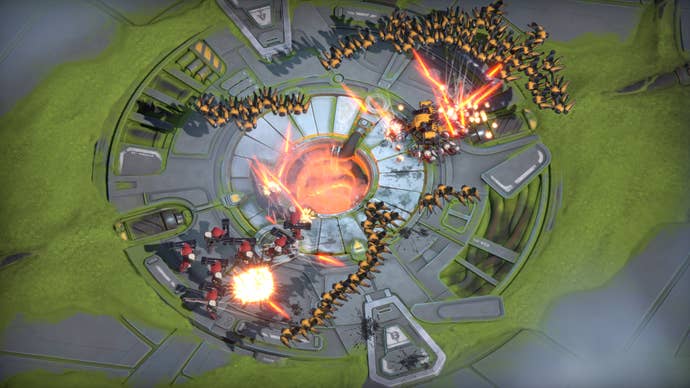Battle Aces feels like a brilliant competitive RTS for the TikTok generation - and also the old, somehow
The classic genre is evolving.
The whole thing now, I’m told, is that everybody has a short attention span. Are you still reading? Are you drifting? Focus! The old-man-shouts-at-cloud element blames this on phones, on social media, on whatever else. Whatever the reason, it feels like a real phenomenon - and perhaps that’s why the real time strategy genre has stumbled a bit in recent decades.
I used to be really rather good at certain RTS titles, having been in the high-end percentile for online play in a couple of classics. I still boot stuff like Starcraft 2 and Red Alert 3 from time to time for a nostalgia-stroking skirmish. But one thing I note is: it’s a genre that takes time. A good match is probably half an hour. That’s probably a tall ask if your primary media consumption is reels. Or, if like me, you’re in your thirties, with a family, a work to-do list longer than the firing range of a sniper hero unit, and limited free time.
The solution to that conundrum may very well be Battle Aces, a new RTS from Uncapped Games that I got to play a few matches of.
The big pitch of Battle Aces is that matches can be over in as little as ten minutes. Less, even. At first, sitting down to play it, I begin to get the fear: this could well be some mobile-like thing that misses the glorious micro and macro strategy of the genre. But quickly I realize that isn’t true - in fact, this is a full-fat RTS game - it just has the speed dial overclocked.
A lot of things happen in one click, and are instant. When the match starts you already have a single base with resource-mining drones. You can expand your base with a single button press, with the next base placed into a specific, pre-ordained spot on the map. Once that base’s build timer is complete, it instantly pops in with its own set of resource miners. If any resource grabbing units are killed, they are automatically replaced after a short timer elapses - meaning resource guarding and economy sabotaging is still a factor, but you don’t have to focus on queuing up more miners if your opponent gets behind enemy lines.
Unit production is actually instant, so long as you have the resources. A single button press and the unit appears at your base. While there’s a clickable menu in the bottom left, you’ll mostly be spawning units by hammering shortcut buttons like W or S. The idea behind all of this is it eliminates a lot of the slow burn - it gets you right to the fighting.

There’s a minor downside to this, I suppose, if you’re the sort of RTS player that gets a particular kick out of base building. Battle Aces isn’t about that; the extent of base building is dropping down turrets, if you even choose to use them. But in terms of the fighting, there’s clearly granularity here.
In a hands-on demo calibrated clearly just to get people into the game no matter their level of knowledge, I’m encouraged to drop my rally point for new units next to my army repeatedly and use a Halo Wars style ‘all units’ command to simply send waves of units to the enemy. It’s a tactic that works, here - but depth is clearly there, bubbling away beneath this fire-and-forget setup. There’s the usual RTS shortcuts for things like command groups, for instance, allowing you to battle on multiple fronts and test your ‘micro’ skill.
Beyond the sheer speed, the other thing that sets Battle Aces apart is its structure. There’s no explicit ‘factions’ in the RTS sense - instead, the launch version will feature around 45 units that are unlocked and ‘equipped’ in a deck style. Ultimately you have eight slots, and within a few loose defining parameters can put whatever units you like into those slots to create an army. Basically, you create your own faction.

In a quick-fire game, you can see how this might lend itself to thrilling competition. It’s sort of like injecting the energy of a quick-fire competitive trading card game into the RTS framework. It also helps with the monetization - Battle Aces will be free to play, but will have transactions related to seasons of content that introduce a regular flow of new units to the game.
It’s the sort of game that tickled something for me; it scratched an itch that, until playing, I didn’t even fully recognize was there. I’ll be keenly awaiting the beta and the final release to see how the competitive meta shakes out - but my interest is certainly piqued.

